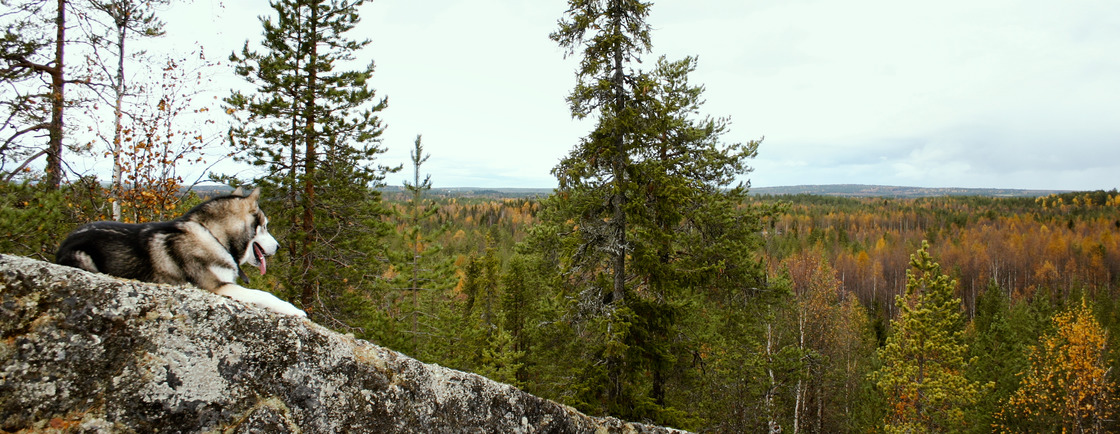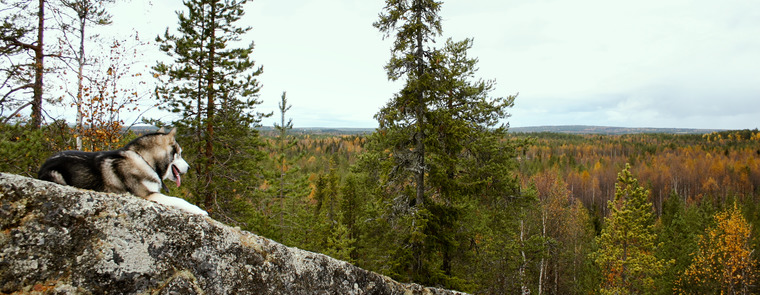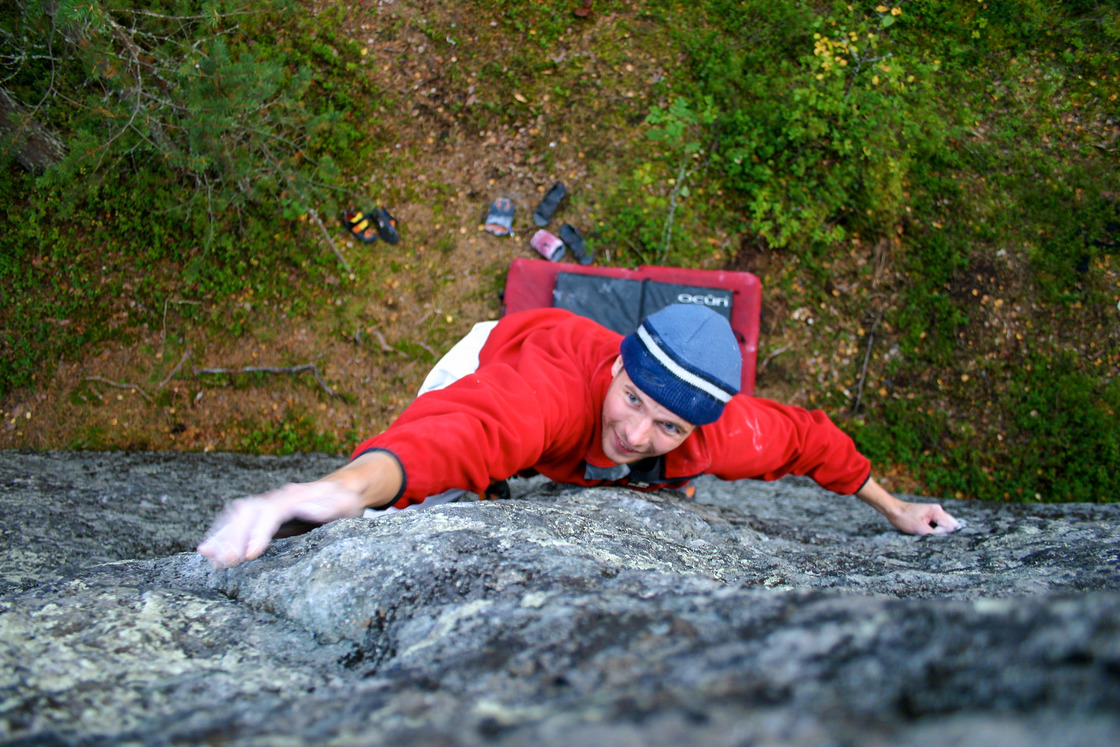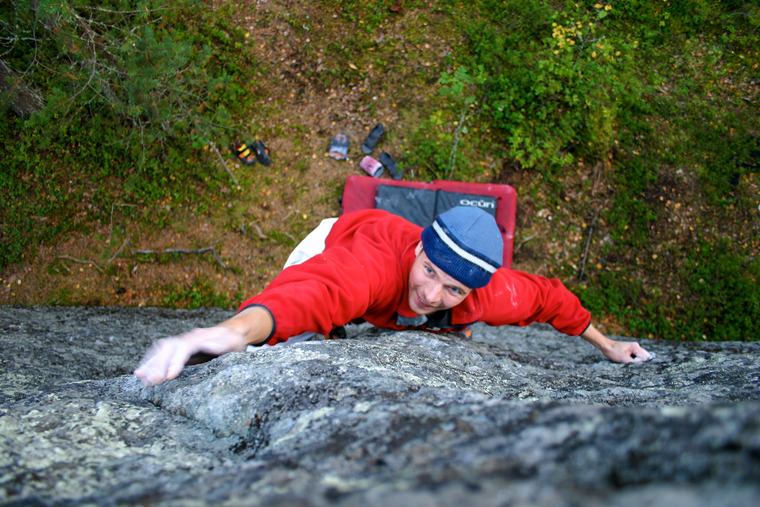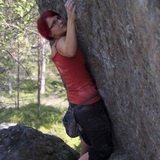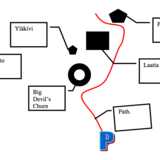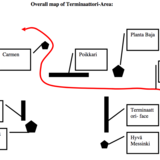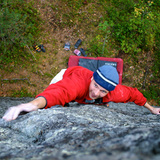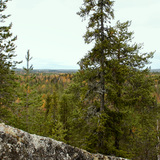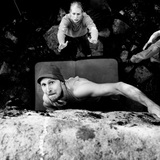Hiidenkirnut a.k.a. Kirnut, roughly translated transforms to Devil’s churns. Hiidenkirnut is a place with unique geology including fourteen “giant’s kettles” or “devils churns”, however you want to call them. The churns that formed about 10 000 years vary from size and shape and they include the biggest one in Finland. Note that there are usually non-climbers checking these sights, so behave and don’t climb in the churns.
When looking from climbing point of view, Hiidenkirnut is the biggest concentration of boulder problems in Lapland. Here you can find pretty much all kinds of problems, no matter are you looking for easy or hard. Rock quality is unique and generally very good. Volcanic style rock has created wide variety of interesting holds and one of the trademark features at Hiidenkirnut are pockets, a very rare thing in Finland. Landings are generally pretty good and usually you should be fine with one big pad.
Navigation at Hiidenkirnut may be bit challenging at times, so the first and most important rule is NOT to take shortcuts. For some reason, success rate of taking shortcuts at Kirnut is very low. Even you would have been roaming these bushes for decades. Stay on the paths, it’s just more convenient. Some vague and mysterious stories have been told about a person, who once took a shortcut at Kirnut and succeeded.
Near the parking area, there is a some kind of unofficial fireplace and a table. There is also a Kota building that you can rent. Renting the Kota you also gain access to firewood and near by toilets.
Enquiries from the village community of Rautiosaari by calling them at +358 40 865 4740.
The first signs of climbing in Lapland trace back to the 80’s. There was only few true pioneers and they were scattered around the province. The first generation climbed mainly in Korouoma, Hirveäkuru and Hiidenkirnut. Also, few rusty pitons can be found from the walls of Luppioberget. In the beginning, traditional climbing was the name of the game and the bouldering was old school style, just a few long traverses and some top rope problems.
First half of the nineties, Hiidenkirnut started to show signs of a new generation. Problem called Kitkasika was a prime example of an old school style bold highball, that was popular at the time. Kitkasika saw it’s first ascent in 1994, same year as Pikku-Paavo. Pikku-Paavo was different as it had new kind of characters, that would come as a standard in the future. In 1997, future to be weatherman, returned from Yosemite to Rovaniemi and he had seen the “future” of bouldering. Realization was that the boulders don’t necessary have to be long or tall, they can have sit starts and consist of only few hard moves. This changed everything and created a lot of new potential at Hiidenkirnut.
Second generation created the heart of Hiidenkirnut by sending classic problems like Los Cojones, Hyvä elämä, Las angustias de la vida, NFL, Adios, Pyramid direct, Bolognan Leijonakuningas and many others. The new style would enable the full potential at Hiidenkirnut, potential that would reach to more than 300 boulder problems. Still, climbers were few and development was slow. In comes the bouldering boom of Finland.
Around the millennium, bouldering gain popularity all around Finland. People started to see the true potential of Finland as a bouldering destination. New areas around Finland were developed with unseen volume and speed. This wave of new climbers reached Rovaniemi around 2002 and merged with the second generation. This started a new development in lappish bouldering. Not just at Hiidenkirnut, but all over Lapland. This era gave birth to the classic problems like Midi and it’s sit start. Maitomies, King for a day, Susiraja, Myrsky vesilasissa and several others.
After the sweep of the “new wave”, bouldering in Lapland now extended all the way from the remote shores of Lake Inari to the walls of the courthouse in Rovaniemi. Bouldering in Lapland generally was searching and developing new areas and searching for that “Shangri La”. Hiidenkirnut would become the basecamp where northern bouldering would evolve in difficulty. People were pushing the grades and climbing lines that were still unclimbed at Hiidenkirnut. First 7a was climbed in 1997 and a decade later first 8a was climbed by a former ice cream van driver and the amount of problems in Lapland rapidly increased from 128 all the way to 782 boulders in just seven years.
Today, Hiidenkirnut has naturally quieted down from major development, but few climbers have actively been pushing the limits of difficulty and relentlessly they have been opening new hard problems. These historic phases and the people involved in in them have created a bouldering area where you can experience the bouldering history of Lapland. From Hiidenkirnut you can pretty much find everything from the ridiculously hard sit starts to the bold and mellow highball problems.
We published a guidebook about 10 years ago and we were planning to make a Fontainebleau style circuit to Hiidenkirnut, but we ran out of pages. In that spirit, here is a circuit that I would recommend you to climb while at Hiidenkirnut. The circuit gives a brief tour to history and at the same time gives you a good overall experience of this unique place.
Musti’s circuit
1. Laatta
2. Juusto
3. Pikku-Paavo
4. Viiru
5. Kitkasika
6. Las angustias de la vida
7. Kalamies
8. Mau mau
9. Bolognan leijonakuningas
10. Läskin paluu
11. Pyramid direct
12. Raimo-oo
13. Myrsky vesilasissa assis
14. Los cojones
15. Susiraja
16. Helsinki-Rovaniemi all night long
17. King for a day
18. Maitomies
19. Midi
20. Uskon puute
21. Terminaattori
22. Babylon makes the rules
